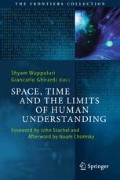Abstract
Through space-adjusting technologies and social practices, innovation has progressively transformed the space and time constraints on the geographical range and nature of human activities, and on the interactivity of people at local through global scales. This essay explores explicit measurements and representations of the time-space convergence and divergence of places and their impacts on individuals, families, communities, regions, and nations. At such scales, the nature of time-space is differentially experienced, based on gradations and cleavages in human conditions that result from socio-economic systems that differentially allocate wealth, education, infrastructure, and other affordances for breaking down the rigidity and restrictions on mobility and opportunity. The essay addresses questions regarding the measurement of time-space convergence at different geographical scales, considers the implications of convergence processes for human well-being, and explores the use of time-geography concepts to help reduce constraints on opportunities for people to engage successfully and equitably in a world where the significance of distance can change rapidly and with uneven impact on places, regions, and nations.
Access this chapter
Tax calculation will be finalised at checkout
Purchases are for personal use only
References
Abler, R. (1973). Monoculture or miniculture? The impact of communications media on culture in space. In D. Lanegran & R. Palm (Eds.), An invitation to geography (pp. 186–195). New York: McGraw-Hill.
Abler, R. F. (1975). Effects of space-adjusting technologies on the human geography of the future. In R. Abler, D. Janelle, A. Philbrick, & J. Sommer (Eds.), Human geography in a shrinking world (pp. 35–56). North Scituate, MA, USA: Duxbury Press.
Adams, P. C. (1995). A reconsideration of personal boundaries in space-time. Annals of the Association of American Geographers, 85(2), 267–285.
Adams, P. C. (2000). Application of a CAD-based accessibility model. In D. G. Janelle & D. Hodge (Eds.), Information, place, and cyberspace: issues in accessibility (pp. 217–239). Berlin: Springer.
Axhausen, K. W., Dolci, C., Fröhlich, Ph., Scherer, M., & Carosio, A. (2008). Constructing time scaled maps: Switzerland 1950–2000. Transport Reviews, 28(3), 391–413.
Buliung, R. N. (2011). Wired people in wired places: stories about machines and the geography of activity. Annals of the Association of American Geographers, 101(6), 1365–1381.
Burns, L. (1979). Transportation, temporal and spatial components of accessibility. Lexington, MA, USA: Lexington Books.
Couclelis, H. (2004). Pizza over the internet: E-commerce, the fragmentation of activity, and the tyranny of the region. Entrepreneurship & Regional Development, 16(1), 41–54.
Ellegård, K., & Svedin, U. (2012). Torsten Hägerstrand’s time-geography as the cradle of the activity approach in transport geography. Journal of Transport Geography, 23, 17–25.
Goodchild, M. F. (2007). Citizens as sensors: The world of volunteered geography. GeoJournal, 69(4), 211–221.
Hägerstrand, T. (1970). What about people in regional science? Papers of the Regional Science Association, 24, 1–12.
Janelle, D. G. (1968). Central place development in a time-space framework. The Professional Geographer, 20, 5–10.
Janelle, D. G. (1969). Spatial reorganization: A model and concept. Annals of the Association of American Geographers, 59, 348–364.
Janelle, D. G. (1973). Measuring human extensibility in a shrinking world. Journal of Geography, 72, 8–15.
Janelle, D. G. (2014). Time-space convergence. In R. J. Stimson (Ed.), Handbook of research methods and applications in spatially integrated social science (pp. 43–60). Cheltenham, UK: Edward Elgar.
Knowles, R. D. (2006). Transport shaping space: Differential collapse in time-space. Journal of Transport Geography, 14, 407–425.
Kwan, M.-P. (2000). Human extensibility and individual hybrid-accessibility in space-time: A multi-scale representation using GIS. In D. G. Janelle & D. Hodge (Eds.), Information, place, and cyberspace: Issues in accessibility (pp. 241–256). Berlin: Springer.
L’Hostis, A. (2009). The shriveled USA: Representing time–space in the context of metropolitanization and the development of high-speed transport. Journal of Transport Geography, 17(6), 433–439.
Miller, H. J. (1991). Modeling accessibility using space-time prism concepts within geographical information systems. International Journal of Geographical Information Systems, 5, 287–301.
Miller, H. J. (2005). A measurement theory for time geography. Geographical Analysis, 37(1), 17–45.
Miller, H. J., & Bridwell, S. A. (2009). A field-based theory for time geography. Annals of the Association of American Geographers, 99, 49–75.
Shaw, S.-L., & Yu, H. (2009). A GIS-based time-geographic approach of studying individual activities and interactions in a hybrid physical-virtual space. Journal of Transport Geography, 17(2), 141–149.
Spiekermann, K., & Wegener, M. (1994). The shrinking continent: New time-space maps of Europe. Environment and Planning B: Planning and Design, 21(6), 653–673.
Tobler, W. (2001). The world is shriveling as it shrinks, presentation at Texas A&M University, 26 October, http://www.geog.ucsb.edu/~tobler/presentations/. Accessed 2 May 2016.
Warf, B. (2008). Time-space compression: Historical geographies. New York: Routledge.
Yu, H., & Shaw, S.-L. (2007). Revisiting Hägerstrand’s time geographic framework for individual activities in the age of instant access. In H. Miller (Ed.), Societies and cities in the age of instant access (pp. 103–118). Dordrecht, NL: Springer Science.
Author information
Authors and Affiliations
Corresponding author
Editor information
Editors and Affiliations
Rights and permissions
Copyright information
© 2017 Springer International Publishing AG
About this chapter
Cite this chapter
Janelle, D.G. (2017). Time, Space, and the Human Geographies of Opportunity. In: Wuppuluri, S., Ghirardi, G. (eds) Space, Time and the Limits of Human Understanding. The Frontiers Collection. Springer, Cham. https://doi.org/10.1007/978-3-319-44418-5_38
Download citation
DOI: https://doi.org/10.1007/978-3-319-44418-5_38
Published:
Publisher Name: Springer, Cham
Print ISBN: 978-3-319-44417-8
Online ISBN: 978-3-319-44418-5
eBook Packages: Physics and AstronomyPhysics and Astronomy (R0)

